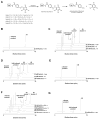Comparative analysis of cleavable azobenzene-based affinity tags for bioorthogonal chemical proteomics
- PMID: 21095571
- PMCID: PMC3103785
- DOI: 10.1016/j.chembiol.2010.09.012
Comparative analysis of cleavable azobenzene-based affinity tags for bioorthogonal chemical proteomics
Abstract
The advances in bioorthogonal ligation methods have provided new opportunities for proteomic analysis of newly synthesized proteins, posttranslational modifications, and specific enzyme families using azide/alkyne-functionalized chemical reporters and activity-based probes. Efficient enrichment and elution of azide/alkyne-labeled proteins with selectively cleavable affinity tags are essential for protein identification and quantification applications. Here, we report the synthesis and comparative analysis of Na₂S₂O₄-cleavable azobenzene-based affinity tags for bioorthogonal chemical proteomics. We demonstrated that ortho-hydroxyl substituent is required for efficient azobenzene-bond cleavage and show that these cleavable affinity tags can be used to identify newly synthesized proteins in bacteria targeted by amino acid chemical reporters as well as their sites of modification on endogenously expressed proteins. The azobenzene-based affinity tags are compatible with in-gel, in-solution, and on-bead enrichment strategies and should afford useful tools for diverse bioorthogonal proteomic applications.
Copyright © 2010 Elsevier Ltd. All rights reserved.
Figures







Comment in
-
Reeling in the catch: advancing cleavable linkers for proteomics.Chem Biol. 2010 Nov 24;17(11):1166-8. doi: 10.1016/j.chembiol.2010.11.001. Chem Biol. 2010. PMID: 21095564
Similar articles
-
Synthesis of Na2S2O4 mediated cleavable affinity tag for labeling of O-GlcNAc modified proteins via azide-alkyne cycloaddition.Bioorg Med Chem Lett. 2021 Sep 15;48:128244. doi: 10.1016/j.bmcl.2021.128244. Epub 2021 Jul 3. Bioorg Med Chem Lett. 2021. PMID: 34229054
-
Comparative analysis of Cu (I)-catalyzed alkyne-azide cycloaddition (CuAAC) and strain-promoted alkyne-azide cycloaddition (SPAAC) in O-GlcNAc proteomics.Electrophoresis. 2016 Jun;37(11):1431-6. doi: 10.1002/elps.201500491. Epub 2016 Mar 1. Electrophoresis. 2016. PMID: 26853435 Free PMC article.
-
Small Molecule Interactome Mapping by Photo-Affinity Labeling (SIM-PAL) to Identify Binding Sites of Small Molecules on a Proteome-Wide Scale.Curr Protoc Chem Biol. 2019 Dec;11(4):e75. doi: 10.1002/cpch.75. Curr Protoc Chem Biol. 2019. PMID: 31763793 Free PMC article.
-
Chemical proteomics: ligation and cleavage of protein modifications.Curr Opin Chem Biol. 2013 Feb;17(1):110-7. doi: 10.1016/j.cbpa.2012.11.007. Epub 2012 Dec 28. Curr Opin Chem Biol. 2013. PMID: 23273612 Review.
-
Applications of copper-catalyzed click chemistry in activity-based protein profiling.Molecules. 2014 Jan 27;19(2):1378-93. doi: 10.3390/molecules19021378. Molecules. 2014. PMID: 24473203 Free PMC article. Review.
Cited by
-
Sulfenic acid chemistry, detection and cellular lifetime.Biochim Biophys Acta. 2014 Feb;1840(2):847-75. doi: 10.1016/j.bbagen.2013.05.040. Epub 2013 Jun 6. Biochim Biophys Acta. 2014. PMID: 23748139 Free PMC article. Review.
-
Mass Spectrometry for O-GlcNAcylation.Front Chem. 2021 Dec 6;9:737093. doi: 10.3389/fchem.2021.737093. eCollection 2021. Front Chem. 2021. PMID: 34938717 Free PMC article. Review.
-
Acute synthesis of CPEB is required for plasticity of visual avoidance behavior in Xenopus.Cell Rep. 2014 Feb 27;6(4):737-47. doi: 10.1016/j.celrep.2014.01.024. Epub 2014 Feb 13. Cell Rep. 2014. PMID: 24529705 Free PMC article.
-
Residual host cell proteins: sources, properties, detection methods and data acquisition modes.Front Microbiol. 2025 Aug 18;16:1658366. doi: 10.3389/fmicb.2025.1658366. eCollection 2025. Front Microbiol. 2025. PMID: 40901073 Free PMC article. Review.
-
Profiling substrates of protein arginine N-methyltransferase 3 with S-adenosyl-L-methionine analogues.ACS Chem Biol. 2014 Feb 21;9(2):476-84. doi: 10.1021/cb4008259. Epub 2013 Dec 9. ACS Chem Biol. 2014. PMID: 24320160 Free PMC article.
References
-
- Bahulayan DJ, Lalithambika LM. Modified clays as efficient acid-base catalyst systems for diazotization and diazocoupling reactions. Synth Comm. 2003;33:863–869.
-
- Best MD. Click chemistry and bioorthogonal reactions: unprecedented selectivity in the labeling of biological molecules. Biochemistry. 2009;48:6571–6584. - PubMed
-
- Böttcher T, Pitscheider M, Sieber SA. Natural products and their biological targets: proteomic and metabolomic labeling strategies. Angew Chem Int Ed. 2010;49:2680–2698. - PubMed
Publication types
MeSH terms
Substances
Grants and funding
LinkOut - more resources
Full Text Sources
Other Literature Sources

